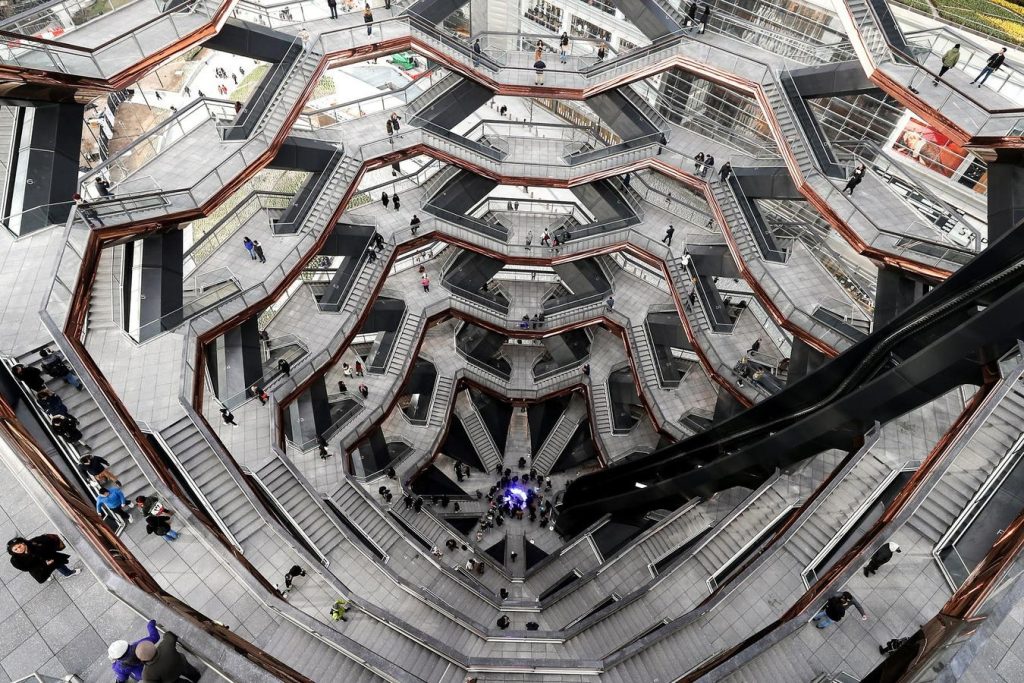Visitors spend time at “The Vessel” a public art structure in Midtown Manhattan on March 18, 2019. The structure is part of the first phase of the Hudson Yards real-estate development project. (Photo by Atilgan Ozdil/Anadolu Agency/Getty Images)
Getty Images
Real estate developments can sometimes feel cut off from the communities they serve. Where’s the integration into the local scene? A new movement addresses that disconnect by investing in the lives and output of local artists. Through programs like an artist-in-residence program at The Upton in Atlanta, developers are weaving creativity into the fabric of their properties.
The thinking goes like this: Art builds connection. Connection builds community. And community transforms living spaces.
Building Communities Through Creativity
The Upton, a new luxury multifamily development by META Real Estate Partners in Atlanta’s Chosewood Park neighborhood, searched for ways to enhance residents’ lives. The project’s principals wanted to connect the property to something other than the cachet of high-end amenities.
The solution was an artist-in-residence program that offered complimentary rent and a stipend over an 18-month residency. Chosen through a nationwide call for proposals, five creatives are now on board, including multidisciplinary artist Adam Stephenson and Atlanta-based painter Sage Guillory.
What will the artists do in the luxury development? Create art and events, which planners trust will cultivate a spirit of creativity while creating a vibrant community.
The Hudson Yards development, including ‘The Vessel,’ stands on the West Side of Midtown Manhattan. Phase one of the Hudson Yards real-estate development project. (Photo by Drew Angerer/Getty Images)
Getty Images
“Building communities starts with people, and how people connect with the building itself is crucial to its success,” says Rob Kincheloe, Partner at META Real Estate Partners. “By programming art throughout the property and having those same artists live within the community, we hope to attract residents who see our property as differentiated.”
Organizers believe the artists will inspire introspection, and ultimately, a deeper sense of belonging among residents, says Melania Armenta, Director of Resident Strategy at Atlanta-based Gallery Residential, which curates the program.
The Growing Trend Of Artists-In-Residence
The Upton has company in its endeavor. Other developers are turning to artist-driven initiatives to create spaces that are both visually engaging and emotionally resonant. While the initiatives may not be a solid trend, they represent fresh thinking in what can be a staid field.
Gallery Residential has spearheaded similar programs: The Linden in Chattanooga, Tennessee; Stella at Five Points in Huntsville, Alabama; and The Tristan in Pensacola, Florida.
Artist Daniela De Castro created this installation for the pool cabana at the Tristan residences in Pensacola, Florida.
Courtesy of Tristan
“We see art as more than a visual element—it’s a bridge to community, identity and lasting value,” says Tracy Bowers, co-founder of Gallery Residential. “We’re intentional about curating artist-driven programs that resonate with residents.”
Adds Gallery Residential co-founder Bruce Sanders: “By partnering with forward-thinking developers, we’re exploring the powerful synergy between art and real estate. These initiatives allow residents to connect with the artists behind the work—fostering deeper emotional ties and transforming everyday spaces.”
Art As A Catalyst For Identity And Value
Several other developments have launched similar initiatives:
Wynwood Walls in Miami has become a renowned street art museum since it opened in 2009. The urban revitalization project has since evolved into a driver for real estate development. The district now has an edgy, mural-filled aesthetic—a draw for younger renters and creatives. Developers of buildings like Wynwood 25 hopped on the trend, incorporating large-scale murals (via artist collaborations) into architecture and branding.
The nonprofit Artspace develops affordable housing for artists, combining residential units with on-site studios, performance areas and gallery spaces. Neighborhoods are revitalized and cultural authenticity is preserved—the latter is often lost when gentrification gears up.
The Guild in Washington, D.C. is a luxury multifamily complex that partners with local artists. Their work rotates throughout the building’s common areas. Marketers term the result as “living in a gallery.”
Park & Paseo in Orange County, CA: A mixed-use development where large-scale art installations are integrated into the leasing and marketing strategies, helping properties stand out in a competitive rental market.
A New Real Estate Model?
Artists, tourists, residents and visitors mingle during Bushwick’s Open Studios in Brooklyn, an annual event when many of the artists living and working in the neighborhood open their art studios to the public. (Photo by Andrew Lichtenstein/Corbis via Getty Images)
Corbis via Getty Images
At The Upton, the focus on art extends to nature. In partnership with Atlanta-based Natural Born Tillers, the development will house a 2,700-square-foot organic garden, including a rooftop edible garden, a blueberry orchard and culinary herb plantings.
Residents will have access to the harvest through “Fresh Harvest Fridays” and garden-to-table dining experiences created by resident chef Justin Dixon, one of Upton’s artists-in-residence.
The blending of art, sustainability and community-building might represent a new model for residential real estate—one where properties exist in a kind of ecosystem. Proponents believe that can translate to a richer, more connected way of living.

